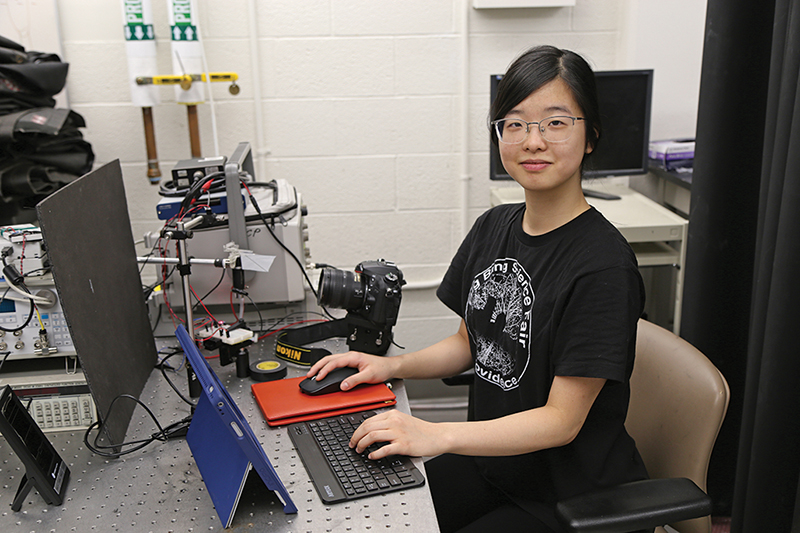Aerodynamics researcher navigates course to success
With help from a Carl Nielsen ’56 Summer Research Fellowship, Katie Wu ’19 furthers Breuer Lab work on a robotic flapping wing with implications for both biological and engineering communities.
You may catch a glimpse of her sitting in the Hazeltine Commons, laptop open, but that does not mean Kit Sum (Katie) Wu ’19 is not fully engaged at that moment with something that is happening in the School of Engineering. So much of what the senior from New York City does for different organizations within the University is done without fanfare, but cannot be overlooked.
She chose Brown knowing her interest in humanities and literature would still be encouraged, even while studying engineering. “Engineering combines science and applications to improve the quality of life,” she said. “Using engineering skills, you can make something visible and interactive. I study mechanical engineering specifically because so much depends on movement in the physical world.”
 Her journey to find a research home in the wind tunnels of Prince Engineering Lab was fueled by her discovery of science in high school, and was a fairly quick matching process for Wu once on campus. During the spring of her first year, she joined Brown’s chapter of the American Society of Mechanical Engineers (ASME) for a group tour of the Fluid Dynamics Research Laboratory, led by Professor Kenny Breuer. The Breuer Lab’s research on bio-inspired flight immediately caught Wu’s eye, and she found herself asking to attend his lab meetings to learn more. Just a few months later, Breuer would invite Wu to participate in ongoing research in his lab.
Her journey to find a research home in the wind tunnels of Prince Engineering Lab was fueled by her discovery of science in high school, and was a fairly quick matching process for Wu once on campus. During the spring of her first year, she joined Brown’s chapter of the American Society of Mechanical Engineers (ASME) for a group tour of the Fluid Dynamics Research Laboratory, led by Professor Kenny Breuer. The Breuer Lab’s research on bio-inspired flight immediately caught Wu’s eye, and she found herself asking to attend his lab meetings to learn more. Just a few months later, Breuer would invite Wu to participate in ongoing research in his lab.
“Katie is an unusually engaged student in the Brown community,” said Breuer. “She has served as an undergraduate teaching assistant, participated in the Sheridan Center Problem Solving course, mastered Japanese and spent the summer after her sophomore year immersed in a Japanese engineering internship. She is active in the Engineering DUG (Department Undergraduate Group) and other campus organizations, all while sustaining a strong interest in research.
“She is smart, dedicated, disciplined and ambitious, but still quiet and unassuming.”
Katie is an unusually engaged student in the Brown community. She has served as an undergraduate teaching assistant, participated in the Sheridan Center Problem Solving course, mastered Japanese and spent the summer after her sophomore year immersed in a Japanese engineering internship.
But not unnoticed. After three years of Japanese in high school, and two more at Brown, Wu’s Japanese professor encouraged her to apply to an international internship program in Japan. She was selected from the pool of applicants for a summer internship in Yokohama. Wu interned as a mechanical engineer at a Japanese electrical engineering company, working with a small research and design group, and saw first-hand how technologies were brought together in the industrial process.
Over the course of last summer, thanks to the Carl Nielsen ’56 Summer Research Fellowship, Wu continued work she had already begun on a robotic flapping wing. One notable characteristic of this wing is that angle of the wing with respect to the incoming flow is not actively controlled by a motor. Instead, its position is passively controlled by a balance of elastic and aerodynamic forces, a characteristic which has been observed in the flight mechanics of insects. Wu mounted the wing on a force transducer to acquire data to understand how differences in wing geometry and wing motion affect the generation of lift and drag for both biological fliers as well as engineering bio-inspired flight vehicles. Among the implications of this work are informing trends that have contributed to the evolution of flight in mammals, as well as provide guidelines to design efficient flapping flight robots for agile flight.
“I’m grateful to the Nielsen fellowship because it allowed me to spend the summer just showing up at the lab every day,” Wu said, citing housing, food, and the ability to save money for graduate school applications as things she worried less about during June, July, and August. Much of Wu’s summer progress was summarized in an oral presentation at the Society for Integrative and Comparative Biology’s annual conference in Tampa in January. She also plans to turn the work into an honors thesis this spring.
It is likely her ability to organize and juggle all these different facets of her life that make her instrumental to campus groups like ENGN DUG, the New Scientist Peer-Advising and Leadership mentoring program, and the Brown University Aikido Club (where she is soon testing for a black belt). She lists Breuer, Dean of the College Rashid Zia (“He makes himself so available!”) and Engineering Associate Dean Rod Beresford (“I’m a frequent guest of his Dean in the Common hours!”) among those who have played a significant role shaping her education, and encouraging her along the way. “But the list could be much, much longer,” she said.